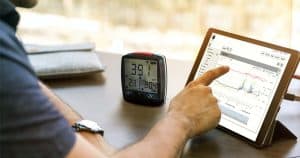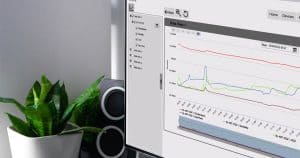With increased worries about the health effects of air pollution, collecting precise and trustworthy Indoor Air Quality data is more critical than ever.
An Indoor Air Quality Monitor may give useful information on pollutant levels such as particle matter, volatile organic compounds (VOCs), carbon dioxide (CO2), and humidity, allowing you to take proactive steps to enhance air quality and safeguard your health. However, with numerous choices on the market, finding the best Indoor Air Quality monitor can be difficult.
This article will walk you through the process of selecting the best Indoor Air Quality Monitor by emphasising important elements to consider, such as sensor accuracy, monitoring capabilities, data interpretation, convenience of use, and budget limits.
Understanding these critical factors allows you to make an informed decision and take proactive efforts to ensure clean and healthy indoor air for yourself and those around you.
What is an Indoor Air Quality Monitor?
Indoor air quality (IAQ) monitors measure and evaluate the air quality in interior settings, including homes, workplaces, schools, and other enclosed spaces.
It makes use of sensors to find and measure different contaminants and other factors that have an impact on the air we breath.
IAQ sensors monitor a range of parameters but predominantly particle matter (PM), VOCs, CO2 levels, humidity, temperature, and, on rare occasions, formaldehyde and radon levels.
An IAQ monitor continually tracks these variables and offers real-time information on the air quality in a specific area.
With the use of this knowledge, users may recognise possible air quality problems, such as excessive pollution levels or insufficient ventilation, and take the necessary steps to reduce them.
By enabling users to make knowledgeable decisions regarding ventilation, filtration, and other actions to enhance the air quality and general well-being of occupants, Indoor Air Quality monitors play a crucial role in creating healthier indoor environments.

Why test Indoor Air Quality
A variety of factors make indoor air quality testing crucial. First off, the quality of the air inside has a direct influence on our health and well-being.
Poor air quality can result in a variety of health problems, including respiratory diseases, allergies, asthma, and even more serious ailments.
By keeping an eye on the interior air quality, we can identify potential pollutants and contaminants. An IAQ monitor’s data enables us to take proactive steps to enhance air quality, such as modifying ventilation, installing air purifiers, or addressing specific pollution sources.
Furthermore, measuring IAQ gives useful information for regulatory compliance, ensuring that buildings and spaces satisfy health and safety regulations.
Regular testing also aids in tracking the efficiency of deployed mitigation techniques and ensures continuous monitoring of air quality for occupant well-being and comfort.
Features to Look for in an Air Quality Monitor
When choosing an IAQ monitor, there are several features to consider:
- Accurate sensors
- Multiple parameter monitoring
- Real-time data and alerts
- History and data logging
- User-friendly interface
- Connectivity and integration
- Calibration and maintenance
With the aid of these qualities, you can find an indoor air quality monitor that meets your requirements and gives you the tools you need to maintain a safe and comfortable interior environment.
Accuracy and precision
When choosing an indoor air quality monitor, accuracy and precision are key variables to consider. Accuracy refers to how well the monitor’s measurements match the real values of the pollutants being monitored.
A highly accurate monitor delivers consistent and exact data, allowing users to make educated decisions about improving air quality. Precision, on the other hand, relates to measurement consistency and reproducibility.
When monitoring the same parameter repeatedly, a high-precision monitor delivers reliable results. Precision and accuracy are both critical for maintaining the validity and dependability of air quality data.
When selecting a monitor, search for monitors that have been tested and calibrated to give accurate and exact measurements, providing consumers confidence in the information they get and allowing them to successfully improve indoor air quality.

Sensor types
To identify and quantify various contaminants, indoor air quality monitors use a variety of sensors. One frequently used sensor is a laser-based optical sensor, which detects and counts airborne particulate matter (PM) based on light scattering.
These sensors offer data on particle concentration and particle size distribution. Another type is the electrochemical sensor, which is frequently used to find gases like carbon monoxide (CO).
When the target gas interacts with the sensing electrode, these sensors measure the electrical current that is produced.
VOC sensors made of metal oxide semiconductors (MOS) work well for this task. When exposed to VOCs, these sensors look for changes in electrical resistance.
Some monitors also utilise sensors to assess and keep an eye on humidity and temperature in addition to pollution.
The choice of an indoor air quality monitor should consider the contaminants that are of concern as well as the precision and dependability requirements for accurate monitoring. Each type of sensor has strengths and limits.
Data logging and reporting
Data logging and reporting are important characteristics of indoor air quality monitors because they allow for the collection, storage, and analysis of air quality data over time.
The monitor continually collects measurements of several parameters with data logging capabilities, producing a historical record of air quality conditions.
This information may be used to track trends, detect patterns, and evaluate the success of air quality improvement measures. Users may produce thorough reports summarising the gathered data, offering a clear picture of air quality trends and any concerns, using the reporting options.
These reports can be distributed to experts, building managers, or health authorities for additional analysis or regulatory compliance. Data logging and reporting enable users to make data-driven decisions, address concerns about air quality, and build healthier indoor settings.

Parameter monitoring
The capacity of an indoor air quality monitor to measure and track many parameters at once is referred to as multiple-parameter monitoring.
This function provides information on a variety of variables that impact air quality, enabling a thorough evaluation of the interior environment.
Users may get a comprehensive picture of the air quality and pinpoint probable sources of discomfort by monitoring a variety of metrics.
Monitoring airborne particles that may cause respiratory problems, for example, may be done by tracking PM levels, whereas monitoring CO2 levels might reveal insufficient ventilation.
Monitoring the temperature and humidity helps to keep the interior atmosphere comfortable and stops the formation of mold.
Multiple parameters may be measured by an IAQ monitor, allowing users to make educated decisions about how to improve IAQ.
Connectivity
Connectivity is an important feature of current indoor air quality sensors. Many air quality monitors now include Wi-Fi or Bluetooth connectivity, these connection capabilities allow users to manage the monitor and view real-time data from smartphones, tablets, and other connected devices.
Users may effortlessly monitor air quality from anywhere by connecting the monitor to a smartphone app or internet platform, receiving rapid warnings, and tracking previous data.
Connectivity also enables smooth interaction with smart home systems, allowing for automation and synchronisation with other devices like air purifiers and thermostats.
Furthermore, linked monitors frequently include sophisticated capabilities such as personalised suggestions, data analysis, and even the option to share air quality data with experts or the public.
Connectivity improves the user experience by making it more easy, efficient, and allowing users to efficiently monitor and regulate indoor air quality.

Friendly User Interface
The interface of an indoor air quality monitor is critical in determining how readily users can interact with and comprehend data. A straightforward and aesthetically appealing user interface provides clear and simple information about the air quality indicators being monitored.
It should have straightforward controls and easy navigation, allowing users to easily access real-time data, alter settings, and see records. A well-designed interface visually engages users by presenting data in clear graphs, charts, or colour-coded indications to swiftly express the air quality state.
An IAQ monitor should include adjustable capabilities that allow users to personalise their monitoring settings and define alarm levels. An easy design makes it easier to grasp and analyse data, allowing users to make more informed decisions.
Cost and Long-Term Value
When selecting an indoor air quality monitor, cost and long-term value are essential variables to consider. While the initial expenditure may vary, it is critical to assess the monitor’s features and capabilities against its cost.
A more expensive monitor may include more precise sensors, better communication options, and other features that contribute to a more thorough air quality evaluation. It is equally critical to consider the long-term worth.
A long-lasting and dependable monitor can last for years, minimising the need for regular replacements. Furthermore, a monitor with data logging and historical monitoring enables users to analyse trends, make educated decisions, and put in place effective methods for preserving healthy indoor environments.
Evaluating the cost and long-term benefit of an indoor air quality monitor allows you to make an educated decision.
Why you should purchase an Indoor Air Quality Monitor from Praxas
Finally, selecting the appropriate indoor air quality monitor is critical for keeping a healthy and pleasant home and work atmosphere. Accurate sensors, various parameter monitoring, real-time alarms, data logging, user-friendly interfaces, connection, and calibration guarantee effective air quality monitoring and improvement.
These essential components are included in Lascar’s air quality monitors, which provide accurate and exact measurements, extensive connectivity choices, and user-friendly interfaces. You may take control of your indoor air quality, make educated decisions, and create a better living or working environment by using Praxas.
Explore Praxas services to learn more about their air quality monitors and how they may assist you in achieving optimal indoor air quality. Accept the power of information and help to build a healthy atmosphere for yourself and those around you with Praxas and Lascar’s Indoor Air Quality Monitors.

